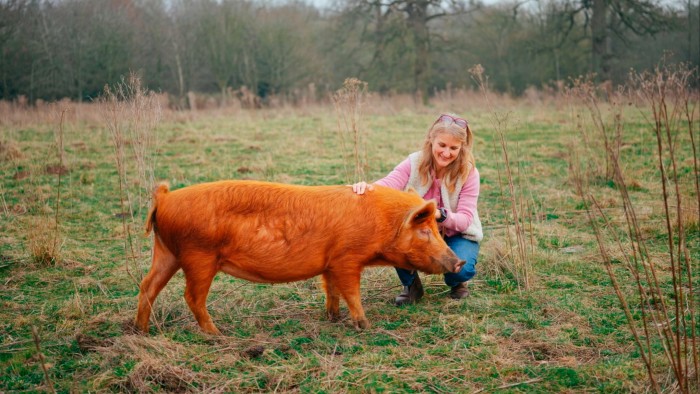Tatjana Greil Castro is no doubt one of few people who has sent an invitation to a “beaver party” without smirking at the double entendre. This is because in February 2024, the co-head of public markets at investment firm Muzinich & Co. watched the Suffolk Wildlife Trust release two adult beavers and three kits into an enclosed lake on her estate, Little Haugh Hall. She became the first person in Suffolk to have beavers on their land for 400 years.
When Castro bought Little Haugh Hall in 2020, it was being used for intensive farming. Since then she has transformed it into a 500-acre estate of mixed woodland, parkland and regenerative farmland. Alongside the beavers, the place is now also home to 20 native-breed cattle, wild ponies and two pigs. “Every evening you hear the owls; the morning birdsong is so loud it’s unbelievable,” she says. “The changes have been enormous.”
Castro is one of a growing number of private individuals inspired to buy farmland with the intention to return it to nature. Many of them are new to rural landowning. A 2024/2025 report by Strutt & Parker surmised that “non-farmers have been playing a growing role in the market in recent years”. In 2024, they accounted for 47 per cent of transactions “compared to the historical 40 per cent” (and the proportion was higher in 2023 and 2022). Many of this new class of rewilder are, like Castro, restoring land to nature “for the love of it”. But there are other motivations: could rewilding be starting to pay?

If Castro’s tale of transformation sounds familiar, you may have read the 2019 book Wilding by Isabella Tree. Published the same year as the 2019 State of Nature report — which found that 41 per cent of UK species had declined since 1970 and 15 per cent were at risk of extinction — the bestseller detailed how she and her husband, Charlie Burrell, allowed nature to reclaim farmland at their family’s Knepp Estate in Sussex. It was Castro’s “gateway” book. “It encouraged me to do it,” she says. “I thought: I’ll buy the land and do what Knepp is doing.”
Rewilding’s popularity has been gathering pace ever since. Shortly before World Rewilding Day celebrated its fifth year on March 20, the government began its long-awaited Land Use Framework consultation. This proposes that 9 per cent of England’s farmland is restored to woodland or heath and a further 8 per cent put into environmental management, to help meet its own legal target to restore or create 500,000 hectares of wildlife-rich habitat by 2042.
Alongside the £25mn Rishi Sunak’s Conservative government allocated to Landscape Recovery schemes, landowners can now receive an initial payment of up to £12,700 per hectare for planting woods on farmland, with annual maintenance payments raised to £400 per hectare, per year, for 15 years thereafter. There are also 250 grants available under Countryside Stewardship schemes, some of which reward the planting of flowers, winter bird food and species-rich grassland with payments of up to £853 per hectare. By contrast, last year arable farms earned an average net margin of £237 per hectare. With farmland vulnerable to erratic weather, commodity prices and fluctuating input costs, replacing wheat with wildlife is starting to show signs it could start to make financial, as well as ecological, sense.


A hundred acres of Castro’s land has been entered into the government’s Woodland Creation programme, as well as some fields sown with flower mixtures. Alongside contributions towards the cost of fencing infrastructure, Castro also gets funding for grazing rare breeds from the Countryside Stewardship scheme. This, she says, “helps keep the land out of arable production”.
The “Knepp effect” is all too familiar to Charlie Wells, managing director of buying agent Prime Purchase. He estimates that 80 per cent of prospective estate buyers now mention rewilding in their first meeting. This is a definite shift. “Four or five years ago they were worried rewilding would devalue their asset because it looks quite scruffy,” he says.
While well-manicured grounds remain desirable, Wells has found that rewilding is equally boast-worthy. “If an agent rings me about land, they will say ‘it’s amazing what they have done’, and then list turtle doves, curlews, indicator species — that’s what buyers want.”

It was the 2019 State of Nature report that prompted Rachel Evatt to take action. Evatt’s tech start-up, Zoombu, was sold to Skyscanner when she was in her early thirties. This allowed her to buy land belonging to a 350-herd dairy farm alongside the home she and her husband had just built in the Peak District. Though the land had been farmed for four generations, Evatt, now a trustee of the charity Rewilding Britain, says the soil was poor. “It had never been possible to grow crops.”
Evatt says the transformation in six years from close-cropped grass to scrub is “remarkable”. Biodiversity has flourished. Owls feed on the teeming vole population living in the longer grass. “We now have all 15 common types of warblers nesting here,” Evatts says. “In our first bird survey, we had only three species present.”
From newly dug ponds full of frogspawn to the 40-strong flocks of house martins building nests along her house, the changes have also been noticed by those who walk public footpaths on her land and report their nature sightings back to her. Growth of new flora and fauna tell their own tale. On the edge of an old quarry, Evatt has found sheep’s-bit scabious, “the only recorded one in Derbyshire”. In a sign of the changing times, she won gold at her local Royal Horticultural Society flower show in 2021 with a wild plants border. She named it “Weed Thriller”.

A 2023 report by the Royal Society for the Protection of Birds, the National Trust and the Wildlife Trust estimated that £56bn will be required to achieve the UK’s nature-related targets by 2050. But, given the Labour government’s recent cessation of the Sustainable Farming Incentive, which compensates landowners for the removal of the basic payment subsidy and rewards nature-friendly farming (the money had all been spent, the Department for Environment, Food & Rural Affairs in effect said in March), it seems unlikely that these funds will come from the public purse. A reformed SFI is expected in the government’s Spending Review this summer.
Hopes are pinned on a much-hyped biodiversity net gain, or BNG, market. Last year, it became mandatory for developers of new building projects to leave natural habitats at least 10 per cent better than before they began building and to maintain them for at least 30 years. If developers cannot do this on their own site they must buy biodiversity “units” from landowners restoring or creating habitats elsewhere under long-term agreements.
The government has introduced standardised metrics and tools to ensure uniformity in how biodiversity increases are measured. These take account of the type of land, from grassland and woodland to lakes and streams, and its size, condition and “strategic significance”. Once priced, the land parcels can then be sold as units on the BNG market.

The government has set targets to build 1.5mn new homes in England over the next five years. The expectation of this housebuilding boom may explain why Defra projected the BNG market would generate £135mn to £247mn a year. All the excitement has helped drive up the price of bare agricultural land. According to estate agents Knight Frank, in 2023, the average “broke the £9,000/acre barrier for the first time” and in January 2025 had climbed to £9,351 per acre.
In this new world of private markets, business nous is a distinct advantage. Both Castro and Evatt are keenly interested in how BNG might finance nature restoration. Despite this, however, both have yet to sell any biodiversity units.
Evatt initially joined a now-defunct Natural England pilot, which attempted to create a centralised system enabling developers to buy BNG units on land being rewilded. But with these units now priced at about £30,000 to £100,000, Evatt says, “the market is just too expensive to flow”. Another issue is local authorities, which are responsible for facilitating deals but “haven’t been given the guidance or resources”. Evatt believes BNG needs a centralised, regulated approach with an insurance backstop to ensure land remains rewilded. Without these, there is “a massive blocker to the market flowing”, she says.


Castro sees additional problems in the BNG market. Having taken a baseline measurement at the beginning of her restoration project in Suffolk, the species that have returned to her land make her confident she can demonstrate biodiversity gains. However, like Evatts, she hasn’t sold these as units.
“I passionately dislike the idea of locking up land for 30 years,” she says, concerned by an assumption inherent in the contract that, after this time, no one will reverse all the work done to restore the land to nature. “That’s a huge presumption.” Castro also advocates for shorter, renewable contracts on another basis. “In five years, someone may want to pay me double what I’m being offered now. It may look attractive today, but in 30? Forget it!”
Prime Purchase’s Wells agrees. For any clients hoping to buy land to make large returns in BNG, he advises caution. “That will only really occur on the larger-scale projects,” he says.
Others are finding a different way to achieve their rewilding dreams with private wealth. After selling her stake in backpack company Osprey Europe, commercial lawyer Julia Davies created a philanthropic model to lend money to organisations and charities for land acquisition. This enables them to move quickly when land becomes available, repaying her over time once sufficient grants and donations are raised.

She says that initially charities were hesitant to borrow, but after a successful 420-acre project at Wild Woodbury in Dorset, where the charity managed to repay the loan within weeks, Davies’ model expanded. In four years, she has helped restore 10,835 acres across 33 sites with £38.5mn in loans. Her initiative, We Have the Power, encourages similar investments.
Davies is clear on the advantage of her initiative. “I am an enthusiast, not an expert. I didn’t really have the knowledge or resources, but I did have the money,” she says. “I didn’t want to just focus all my effort on one piece of land. It made sense to me to do it this way.”
She loves visiting sites when schools, researchers or ecologists come by. As she sees it, “I get all the perks without the burden. I can go almost anywhere in the country and see somewhere I’ve helped restore.”
While enthusiasm for rewilding grows, critics warn of unintended consequences. Patrick Holden of the Sustainable Food Trust warns: “I’m really worried about this headlong rush — which is being effectively supported by the government — into taking land out of [food] production.”

Holden notes “you cannot be against rewilding, of course”, but is concerned that “the more land we take out of production, the more we will be forced to eat food which has been intensively produced, less nutrient dense and likely to contain pesticide residue. Is that really the future we want to step into?”
Now they are a few years into the experiment, rewilders with means, such as Castro, are asking themselves the same questions. “Rewilding is easy,” says Castro. “You put up a fence, add animals and monitor stocking rates.” Now she thinks of her animals as more than ecosystem engineers. “My next ambition is to show how we can have nutrient-dense food without artificial inputs that people are willing to pay a premium for.”
House & Home unlocked

Don’t miss our weekly newsletter, an inspiring, informative edit of the news and trends in global property, interiors, architecture and gardens. Sign up here.
She is working with a contract farmer on the remaining farmland, selling her wheat to regenerative flour business Wildfarmed, and has started a no-dig market garden. “Taking land out of arable is easy,” she says. Harder “is making the arable work”.
Whether these new rewilders want to boast about turtle dove numbers or cash in on a BNG market gathering pace, it is clear that the rewilding movement is here to stay. But now access to nature-friendly farming subsidies are in doubt, one question lingers: if a rewilding land rush follows, what exactly will we eat?
Sarah Langford is the author of ‘Rooted: How Regenerative Farming Can Change the World’
Find out about our latest stories first — follow @ft_houseandhome on Instagram







